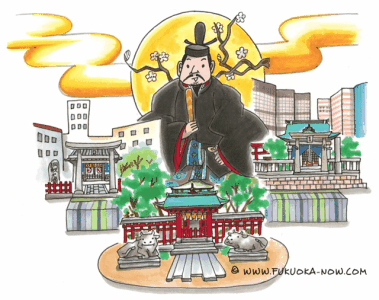Hakata Culture vol.95
Tenmangu: The Origin of Tenjin's Name

Tenmangu are Shinto shrines dedicated to Sugawara no Michizane, the god of learning. There are many tenmangu throughout Japan, but one of the most famous of these shrines is in Dazaifu, where Michizane passed away. Another shrine, Suikyo Tenmangu, is located in the middle of Tenjin, Fukuoka's bustling downtown, and it is also the origin of the name 'Tenjin'. Tenjin was another way to refer to tenmangu, and Michizane was also referred to as Tenjin-sama. For this reason, people started calling the area around Suikyo Tenmangu Tenjin. The shrine was originally located in Imaizumi and it was called Suikyo-no-Tenjin or Sugatami Tenjin. It was built there because when Michizane first came to Hakata, he was said to have peered into a nearby river (now Yakuin Shinkawa) and lamented his haggard-looking reflection. The shrine was moved to its current location in 1612 because Nagamasa Kuroda, the first lord of the Fukuoka Domain, wanted it to protect the northeastern gate of Fukuoka Castle. That is when it became known as Suikyo Tenmangu. Today, Suikyo Tenmangu is a quiet oasis amid towering modern office buildings. Suikyo Tenmangu Yokocho, the narrow alley next to the shrine, maintains an old-time atmosphere with a jumble of tiny restaurants.
Not far from here are two other shrines dedicated to Michizane. Kagami Tenmangu, located next to Hakata Riverain, is said to be a spot where Michizane saw his reflection in a mirror upon arriving in Hakata. Just down the road, in Tsunabamachi, is Tsunahiki Tenmangu. It is built on the site where the newly arrived Michizane is said to have met some locals making rugs from rope. Originally called Tsunawa Tenjin, the shrine was later renamed Tsunahiki Tenmangu, and thus the neighborhood became known as Tsunabamachi.
天神の地名の由来となった天満宮
「天満宮」は学問の神様として名高い菅原道真を祭る神社のこと。とりわけ有名なのは道真が亡くなった場所にある太宰府天満宮ですが、このほかにも日本各地に天満宮があります。福岡有数の繁華街である天神の真ん中にも水鏡天満宮(すいきょうてんまんぐう)という神社があり、この天満宮は「天神」という地名の由来になったものです。
天満宮、あるいは菅原道真の別名は「天神様」。このことから水鏡天満宮のある一帯を天神と呼ぶようになったのです。もともとこの神社は現在の今泉地区にあり、「水鏡天神(すいきょうのてんじん)あるいは「容見天神(すがたみてんじん)」と呼ばれていました。道真が博多に上陸した際、近くの川(現在の薬院新川)に自分の姿を映し、やつれた姿を嘆き悲しんだことにちなんで建立されました。
江戸時代の初期、1612年に福岡藩の初代藩主・黒田長政によって、福岡城の鬼門を守るために現在地に移され、水鏡天満宮という名前になりました。近代的なオフィスビルが建ち並ぶ中にあって、この天満宮だけは静かな空間が広がっています。隣接する水鏡天満宮横丁は狭い路地に小さな飲食店がひしめき合い、昔ながらの雰囲気を醸し出しています。
近くには道真ゆかりの天満宮がほかにもあります。博多リバレイン横にある鏡天満宮は、道真が博多に到着したときに鏡で姿を映した場所と伝わります。さらに博多区綱場町にある綱敷天満宮は、上陸した道真を住民たちが綱で敷物を作って出迎えた場所とされます。もとは綱輪(つなわ)天神と呼ばれ、その後に綱敷天満宮という名前に改められました。こちらも綱場(つなば)町という地名の由来となっています。

